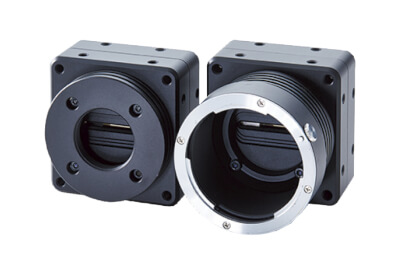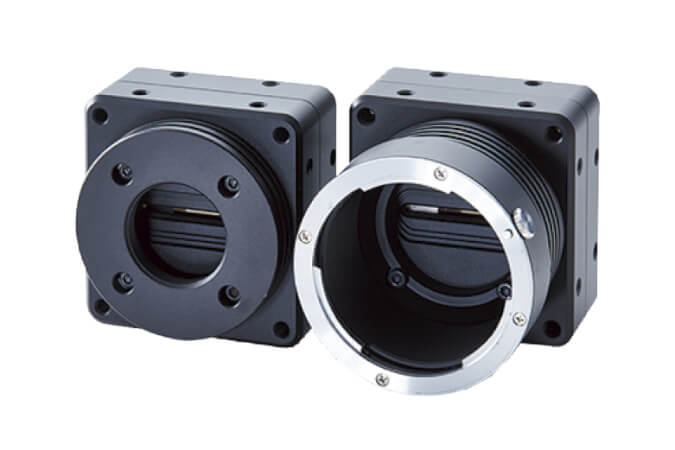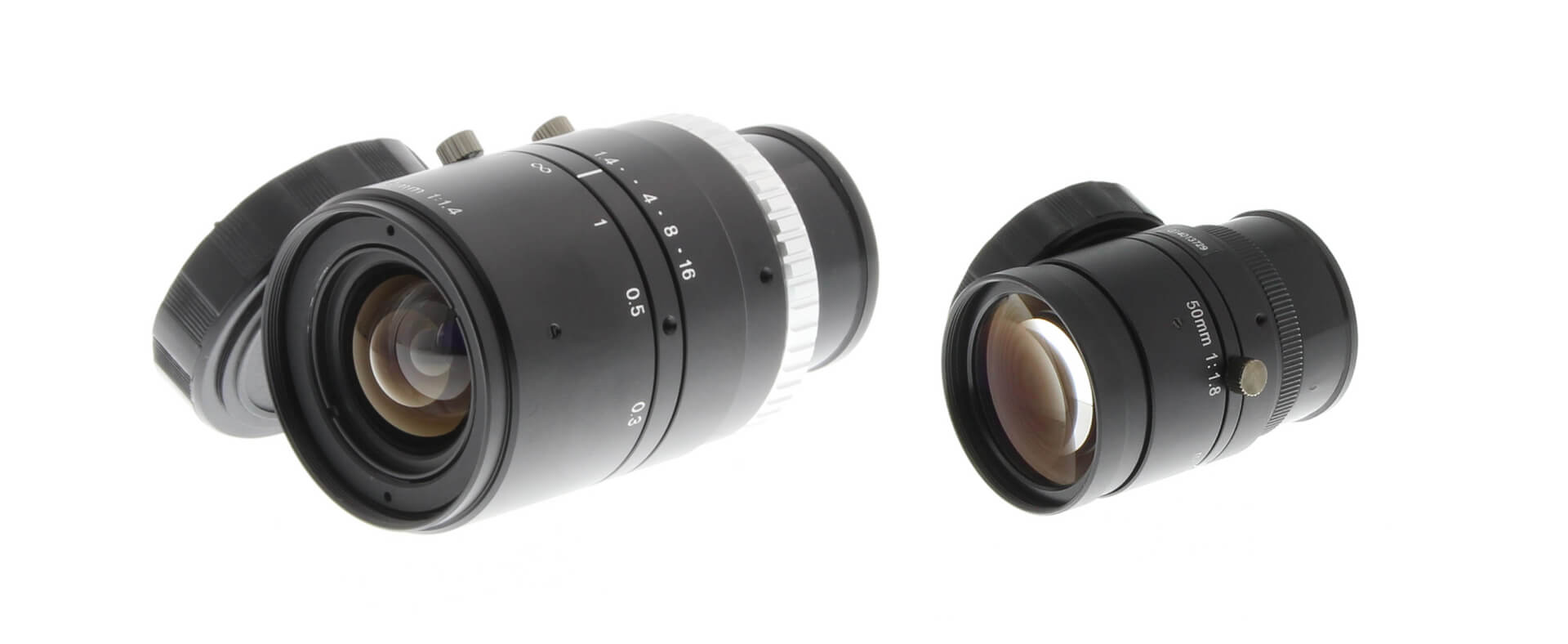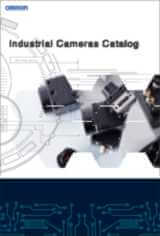Specifications & ordering info
| Produkt | Camera type | Number of lines | Interface | Lens mount | Image width | Image sensor type | Pixel size | Scan frequency | Lens type | Scan type | Description | |
|---|---|---|---|---|---|---|---|---|---|---|---|---|
|
|
Monochrome | 1 | Camera Link | M72 | 16384 pixels | DR-B&W | 3.5 µm | 80 kHz | Not Applicable | Line scan | Camera Link Line Scan Camera, 16K, Monochrome , CMOS AWAIBA DR-B&W-16K-3.5, 3.5 µm, 40 kHz, M72 Mount, Field Update Capability |
|
|
|
Monochrome | 1 | Camera Link | C-mount | 2048 pixels | DR-B&W | 7 µm | 80 kHz | Not Applicable | Line scan | Camera Link Line Scan Camera, 2K, Monochrome, CMOS AWAIBA DR-B&W-2K-7, 7 µm, 80 kHz, C Mount, Field Update Capability |
|
|
|
Monochrome | 1 | Camera Link | F-mount | 2048 pixels | DR-B&W | 7 µm | 80 kHz | Not Applicable | Line scan | Camera Link Line Scan Camera, 2K, Monochrome, CMOS AWAIBA DR-B&W-2K-7, 7 µm, 80 kHz, F Mount, Field Update Capability |
|
|
|
Monochrome | 1 | Camera Link | M42 | 2048 pixels | DR-B&W | 7 µm | 80 kHz | Not Applicable | Line scan | Camera Link Line Scan Camera, 2K, Monochrome, CMOS AWAIBA DR-B&W-2K-7, 7 µm, 80 kHz, M42 Mount, Field Update Capability |
|
|
|
Monochrome | 2 | Camera Link | C-mount | 2048 pixels | DR-B&W | 7 µm | 80 kHz | Not Applicable | Line scan | Camera Link Dual Line Scan Camera, 2K, Monochrome, CMOS AWAIBA DR-B&W-2x2K-7, 7 µm, 80 kHz, C Mount, Field Update Capability |
|
|
|
Monochrome | 2 | Camera Link | F-mount | 2048 pixels | DR-B&W | 7 µm | 80 kHz | Not Applicable | Line scan | Camera Link Dual Line Scan Camera, 2K, Monochrome, CMOS AWAIBA DR-B&W-2x2K-7, 7 µm, 80 kHz, F Mount, Field Update Capability |
|
|
|
Monochrome | 2 | Camera Link | M42 | 2048 pixels | DR-B&W | 7 µm | 80 kHz | Not Applicable | Line scan | Camera Link Dual Line Scan Camera, 2K, Monochrome, CMOS AWAIBA DR-B&W-2x2K-7, 7 µm, 80 kHz, M42 Mount, Field Update Capability |
|
|
|
Monochrome | 2 | GigE | C-mount | 2048 pixels | DR-2 x 2K-7-inver | 7 µm | 26 kHz | Not Applicable | Line scan | GigE Dual Line Scan Camera, 2x 2K, monochrome, CMOS AWAIBA DR-2X2K-7-inver, 7.0 µm, 51 kHz, C-Mount, POE |
|
|
|
Monochrome | 2 | GigE | F-mount | 2048 pixels | DR-2 x 2K-7-inver | 7 µm | 26 kHz | Not Applicable | Line scan | GigE Dual Line Scan Camera, 2x 2K, monochrome, CMOS AWAIBA DR-2X2K-7-inver, 7.0 µm, 51 kHz, F-Mount, POE |
|
|
|
Monochrome | 2 | GigE | M42 | 2048 pixels | DR-2 x 2K-7-inver | 7 µm | 26 kHz | Not Applicable | Line scan | GigE Dual Line Scan Camera, 2x 2K, monochrome, CMOS AWAIBA DR-2X2K-7-inver, 7.0 µm, 51 kHz, M42-Mount, POE |
|
|
|
Monochrome | 1 | GigE | C-mount | 2048 pixels | DR-2K-7 | 7 µm | 51 kHz | Not Applicable | Line scan | GigE Line Scan Camera, 2K, Monochrome, CMOS AWAIBA DR-2K-7, 7.0 µm, 51 kHz, C-Mount, POE |
|
|
|
Monochrome | 1 | GigE | F-mount | 2048 pixels | DR-2K-7 | 7 µm | 51 kHz | Not Applicable | Line scan | GigE Line Scan Camera, 2K, Monochrome, CMOS AWAIBA DR-2K-7, 7.0 µm, 51 kHz, F-Mount, POE |
|
|
|
Monochrome | 1 | GigE | M42 | 2024 pixels | DR-2K-7 | 7 µm | 51 kHz | Not Applicable | Line scan | GigE Line Scan Camera, 2K, Monochrome, CMOS AWAIBA DR-2K-7, 7.0 µm, 51 kHz, M42 Mount, POE |
|
|
|
Monochrome | 1 | Camera Link | F-mount | 4096 pixels | DR-B&W | 7 µm | 80 kHz | Not Applicable | Line scan | Camera Link Line Scan Camera, 4K, Monochrome, CMOS AWAIBA DR-B&W-4K-7, 7 µm, 80 kHz, F Mount, Field Update Capability |
|
|
|
Monochrome | 1 | Camera Link | M42 | 4096 pixels | DR-B&W | 7 µm | 80 kHz | Not Applicable | Line scan | Camera Link Line Scan Camera, 4K, Monochrome, CMOS AWAIBA DR-B&W-2x4K-7, 7 µm, 80 kHz, M42 Mount, Field Update Capability |
|
|
|
Monochrome | 1 | GigE | F-mount | 4096 pixels | DR-4K-7 | 7 µm | 26 kHz | Not Applicable | Line scan | GigE Line Scan Camera, 4K, Monochrome, CMOS AWAIBA DR-4K-7, 7.0 µm, 13 kHz, F-Mount, POE |
|
|
|
Monochrome | 1 | GigE | M42 | 4096 pixels | DR-4K-7 | 7 µm | 26 kHz | Not Applicable | Line scan | GigE Line Scan Camera, 4K, Monochrome, CMOS AWAIBA DR-4K-7, 7.0 µm, 13 kHz, M42 Mount, POE |
|
|
|
Monochrome | 1 | Camera Link | F-mount | 8192 pixels | DR-B&W | 3.5 µm | 80 kHz | Not Applicable | Line scan | Camera Link Line Scan Camera, 8K, Monochrome, CMOS AWAIBA DR-B&W-8K-3.5, 3.5 µm, 80 kHz, F Mount, Field Update Capability |
|
|
|
Monochrome | 1 | Camera Link | M42 | 8192 pixels | DR-B&W | 3.5 µm | 80 kHz | Not Applicable | Line scan | Camera Link Line Scan Camera, 8K, Monochrome, CMOS AWAIBA DR-B&W-8K-3.5, 3.5 µm, 80 kHz, M42 Mount, Field Update Capability |
|
|
|
Monochrome | 1 | GigE | F-mount | 8192 pixels | DR-8K-3.5 | 3.5 µm | 13 kHz | Not Applicable | Line scan | GigE Line Scan Camera, 8K, Monochrome, CMOS AWAIBA DR-8K-3.5, 3.5 µm, 13 kHz, F-Mount, POE |
|
|
|
Monochrome | 1 | GigE | M42 | 8192 pixels | DR-8K-3.5 | 3.5 µm | 13 kHz | Not Applicable | Line scan | GigE Line Scan Camera, 8K, Monochrome, CMOS AWAIBA DR-8K-3.5, 3.5 µm, 13 kHz, M42 Mount, POE |
|
|
|
Monochrome | 1 | Camera Link | M72 | 8192 pixels | DR-B&W | 7 µm | 80 kHz | Not Applicable | Line scan | Camera Link Line Scan Camera, 8K, Monochrome, CMOS AWAIBA DR-B&W-8K-7, 7 µm, 80 kHz, M72 Mount, Field Update Capability |
|
|
|
Monochrome | 2 | Camera Link | M72 | 8192 pixels | DR-B&W | 7 µm | 80 kHz | Not Applicable | Line scan | Camera Link Dual Line Scan Camera, 8K, Monochrome, CMOS AWAIBA DR-B&W-2x8K-7, 7 µm, 80 kHz, M72 Mount, Field Update Capability |
|
|
|
Color | 2 | Camera Link | F-mount | 4096 pixels | DR-RGB | 7 µm | 75 kHz | Not Applicable | Line scan | Camera Link Dual Line Scan Camera, 4K, Color, CMOS AWAIBA DR-RGB-2x4K-7, 7 µm, 75 kHz, F Mount, Field Update Capability |
|
|
|
Color | 2 | Camera Link | M42 | 4096 pixels | DR-RGB | 7 µm | 75 kHz | Not Applicable | Line scan | Camera Link Dual Line Scan Camera, 4K, Color, CMOS AWAIBA DR-RGB-2x4K-7, 7 µm, 75 kHz, M42 Mount, Field Update Capability |
|
|
|
Color | 2 | GigE | F-mount | 4096 pixels | DR-2 x 4K-7-inver-RGB | 7 µm | 13 kHz | Not Applicable | Line scan | GigE Dual Line Scan Camera, 2x 4K, color, CMOS AWAIBA DR-2X4K-7-inver-RGB, 7.0 µm, 13 kHz, F-Mount, POE |
|
|
|
Color | 2 | GigE | M42 | 4048 pixels | DR-2 x 4K-7-inver-RGB | 7 µm | 13 kHz | Not Applicable | Line scan | GigE Dual Line Scan Camera, 2x 4K, color, CMOS AWAIBA DR-2X4K-7-inver-RGB, 7.0 µm, 13 kHz, M42-Mount, POE |
|
|
|
Color | 2 | Camera Link | M72 | 8192 pixels | DR-RGB | 7 µm | 75 kHz | Not Applicable | Line scan | Camera Link Dual Line Scan Camera, 8K, Color, CMOS AWAIBA DR-RGB-2x8K-7, 7 µm, 40 kHz, M72 Mount, Field Update Capability |
|
Need assistance?
We’re here to help! Reach out, and our specialists will assist you in finding the best solution for your business.
Kontakt meg Line Scan

Takk for din forespørsel. Vi vil kontakte deg så snart som mulig.
Vi har for tiden tekniske problemer. Ditt skjema har ikke blitt innsendt. Vi beklager så mye og håper du vil prøve igjen senere. Detaljer:
DownloadTilbud for Line Scan
Ved å fylle ut dette skjemaet vil du motta et tilbud på det valgte produktet. Vennligst fyll inn alle obligatoriske felter. Dine personlige opplysninger vil bli behandlet konfidensielt.

Takk for din tilbudsforespørsel. Vi vil sende deg det forespurte tilbudet så snart som mulig.
Vi har for tiden tekniske problemer. Ditt skjema har ikke blitt innsendt. Vi beklager så mye og håper du vil prøve igjen senere. Detaljer:
DownloadFeatures
What is Line Scan?
A line-scan camera has a single row of pixel sensors, instead of a matrix of them. The frames are continuously fed to a computer that joins them to each other and makes an image. This makes possible sharp pictures of objects that have passed the camera at high speed. Sporting races commonly use this kind of camera to make photo finishes, i.e. determine the winner when multiple competitors cross the finishing line at nearly the same time. These cameras can also be used as industrial instruments for analyzing fast processes.
What is Camera Link?
Camera Link is a serial communication protocol standard designed for computer vision applications based on the National Semiconductor interface Channel-link. It was designed for the purpose of standardizing scientific and industrial video products including cameras, cables and frame grabbers. The standard is maintained and administered by the Automated Imaging Association or AIA, the global machine vision industry's trade group.
Camera Link uses one to three Channel-link transceiver chips with four links at 7 serial bits each. At a minimum, Camera Link uses 28 bits to represent up to 24 bits of pixel data and 3 bits for video sync signals, leaving one spare bit. The video sync bits are Data Valid, Frame Valid, and Line Valid. The data are serialized 7:1, and the four data streams and a dedicated clock are driven over five LVDS pairs. The receiver accepts the four LVDS data streams and LVDS clock, and then drives the 28 bits and a clock to the board. The camera link standard calls for these 28 bits to be transmitted over 4 serialized differential pairs with a serialization factor of 7. The parallel data clock is transmitted with the data. Typically a 7x clock must be generated by a PLL or SERDES block in order to transmit or receive the serialized video. To deserialize the data, a shift register and counter may be employed. The shift register catches each of the serialized bits, one at a time, then registers the data out into the parallel clock domain - once the data counter has reached its terminal value.
Complementary metal–oxide–semiconductor (CMOS) /ˈsiːmɒs/ is a technology for constructing integrated circuits. CMOS technology is used in microprocessors, microcontrollers, static RAM, and other digital logic circuits. CMOS technology is also used for several analog circuits such as image sensors (CMOS sensor), data converters, and highly integrated transceivers for many types of communication. Frank Wanlass patented CMOS in 1963 (US patent 3,356,858). CMOS is also sometimes referred to as complementary-symmetry metal–oxide–semiconductor (or COS-MOS). The words "complementary-symmetry" refer to the fact that the typical digital design style with CMOS uses complementary and symmetrical pairs of p-type and n-type metal oxide semiconductor field effect transistors (MOSFETs) for logic functions. Two important characteristics of CMOS devices are high noise immunity and low static power consumption. Since one transistor of the pair is always off, the series combination draws significant power only momentarily during switching between on and off states. Consequently, CMOS devices do not produce as much waste heat as other forms of logic, for example transistor–transistor logic (TTL) or NMOS logic, which normally have some standing current even when not changing state. CMOS also allows a high density of logic functions on a chip. It was primarily for this reason that CMOS became the most used technology to be implemented in VLSI chips. The phrase "metal–oxide–semiconductor" is a reference to the physical structure of certain field-effect transistors, having a metal gate electrode placed on top of an oxide insulator, which in turn is on top of a semiconductor material. Aluminium was once used but now the material is polysilicon. Other metal gates have made a comeback with the advent of high-k dielectric materials in the CMOS process, as announced by IBM and Intel for the 45 nanometre node and beyond.
What is resolution?
Image resolution is the detail an image holds. The term applies to raster digital images, film images, and other types of images. Higher resolution means more image detail. Image resolution can be measured in various ways. Basically, resolution quantifies how close lines can be to each other and still be visibly resolved. Resolution units can be tied to physical sizes (e.g. lines per mm, lines per inch), to the overall size of a picture (lines per picture height, also known simply as lines, TV lines, or TVL), or to angular subtenant. Line pairs are often used instead of lines; a line pair comprises a dark line and an adjacent light line. A line is either a dark line or a light line. A resolution 10 lines per millimeter means 5 dark lines alternating with 5 light lines, or 5 line pairs per millimeter (5 LP/mm). Photographic lens and film resolution are most often quoted in line pairs per millimeter.




